History
Until the 19th century, Strangeways was rural, with Strangeways Hall, Park and Gardens. Strangeways was recorded in 1322 as Strangwas, from the Anglo-Saxon Strang and gewæsc meaning "[a place by] a stream with a strong current".

Strangeways is an area of inner north Manchester, England, around Strangeways Prison just north of the city centre.
Until the 19th century, Strangeways was rural, with Strangeways Hall, Park and Gardens. Strangeways was recorded in 1322 as Strangwas, from the Anglo-Saxon Strang and gewæsc meaning "[a place by] a stream with a strong current".


Strangeways Brewery was famous as the home of Boddingtons Bitter. It closed in 2005 and was demolished in 2007. [1]

Chatsworth House is a stately home in the Derbyshire Dales, 3.5 miles (5.6 km) north-east of Bakewell and 9 miles (14 km) west of Chesterfield, England. The seat of the Duke of Devonshire, it has belonged to the Cavendish family since 1549. It stands on the east bank of the River Derwent, across from hills between the Derwent and Wye valleys, amid parkland backed by wooded hills that rise to heather moorland. The house holds major collections of paintings, furniture, Old Master drawings, neoclassical sculptures and books. Chosen several times as Britain's favourite country house, it is a Grade I listed property from the 18th century, altered in the 19th. In 2011–2012 it underwent a £14-million restoration. The owner is the Chatsworth House Trust, an independent charitable foundation, on behalf of the Cavendish family.

The Moss is a brook in North East Derbyshire, England.

Walton is an area of Liverpool, England, north of Anfield and east of Bootle and Orrell Park. Historically in Lancashire, it is largely residential, with a diverse population.
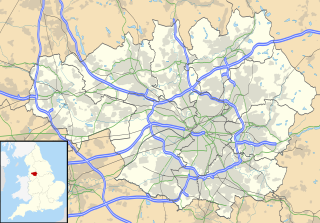
Whalley Range is an area of Manchester, England, about 2 miles (3.2 km) southwest of the city centre. The population at the 2011 census was 15,430. Historically in Lancashire, it was one of the earliest of the city's suburbs, built by local businessman Samuel Brooks.

Pendlebury is a town in the City of Salford, Greater Manchester, England. The population at the 2011 Census was 13,069. It lies 4.1 miles (6.6 km) northwest of Manchester city centre, 3.4 miles (5.5 km) northwest of Salford, and 5.9 miles (9.5 km) southeast of Bolton.

HM Prison Manchester is a high-security men's prison in Manchester, England, operated by Her Majesty's Prison Service. It is still commonly referred to as Strangeways, which was its former official name derived from the area in which it is located, until it was rebuilt following a major riot in 1990.
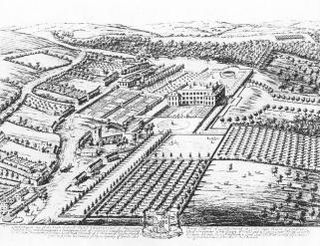
Londesborough Hall is a country house in the village of Londesborough in the East Riding of Yorkshire, England, close to the towns of Market Weighton and Pocklington.

Ardwick Green is a public space in Ardwick, Manchester, England. It began as a private park for the residents of houses surrounding it before Manchester acquired it in 1867 and turned it into a public park with an ornamental pond and a bandstand.

Rivington is a village and civil parish of the Borough of Chorley, Lancashire, England, occupying 2,538 acres. It is about 6 miles (9.7 km) southeast of Chorley and about 8+1⁄2 miles (13.7 km) northwest of Bolton. Rivington is a rural area consisting primarily of agricultural grazing land, moorland, with hill summits including Rivington Pike and Winter Hill within the West Pennine Moors. The area has a thriving tourist industry centred around reservoirs created to serve Liverpool in the Victorian era and Lever Park created as a public park by William Lever at the turn of the 20th century, with two converted barns, a replica of Liverpool Castle and open countryside. Rivington and its village had a population of 109 at the 2011 Census.
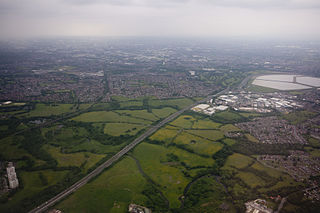
Reddish Vale is in the Tame Valley close to Reddish, Greater Manchester, England. The centre of the vale is around the bottom of Reddish Vale Road. Reddish Vale Country Park is a country park managed by Stockport Metropolitan Borough Council. It covers 161 hectares in all and comprises some of the traditional Reddish Vale area, Reddish Vale Farm and the grazing land and Woodhall Fields, about half a mile to the south. Part of it is a designated local nature reserve.
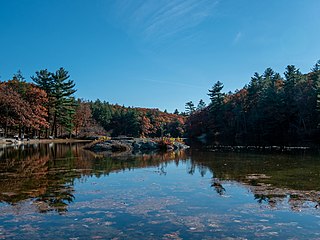
Breakheart Reservation is a public recreation area covering 652 acres (264 ha) in the towns of Saugus and Wakefield, Massachusetts. The reservation features a hardwood forest, two freshwater lakes, a winding stretch of the Saugus River, and scenic views of Boston and rural New England from rocky hilltops. The park is managed by the Massachusetts Department of Conservation and Recreation.

Newall Green is an area in the Wythenshawe district of Manchester, England. It is on the west side of the M56 motorway, approximately 1 mile from Wythenshawe Town Centre.

Strangeways Brewery was a landmark in Manchester, England, just north of the city centre, which was famous as the home of Boddingtons Bitter. It closed in 2005 and was demolished in 2007.
Kempton Park, England formerly an expanded manor known as Kempton, Kenton and other forms, today refers to the land owned by the Jockey Club: Kempton Park nature reserve and Kempton Park Racecourse in the Spelthorne district of Surrey. Today's landholding was the heart of, throughout the Medieval period, a private parkland – and its location along with its being a royal manor rather than ecclesiastic, or high-nobility manor led to some occasional residence by Henry III and three centuries later hunting among a much larger chase by Henry VIII and his short-reigned son, Edward VI.
Philips Park is an area of parkland situated within the Metropolitan Borough of Bury on the boundary of Whitefield and Prestwich, in Greater Manchester. The park consists of rich woodland and grassland habitat and is home to an assortment of wildlife. Two thirds of the site was once the Philips family estate, and the remainder, known as Waterdale, is Irwell Valley land reclaimed following the demolition of two bleach and dye works. The park is a local nature reserve.
Ashbourne Hall is a Manor house originally built by the Cockayne family in the 13th century in Ashbourne, Derbyshire. The present building is part of a largely demolished, Georgian-styled hall built in the 18th century.

The Chestnut Hill–Plateau Historic District is a historic area in the Highland Park neighborhood of Richmond, Virginia. It is also known as 'Highland Park Southern Tip' on city neighborhood maps.

The River Hart is a tributary of the River Whitewater in north Hampshire, England. It rises at Ashley Head spring in Crondall and flows north to meet the Whitewater at Bramshill.

Worsley New Hall is a former mansion and gardens by the Bridgewater Canal in Worsley, Greater Manchester, England, 8 miles (13 km) west of Manchester. The gardens were renovated by the Royal Horticultural Society and opened as RHS Garden Bridgewater in 2021.
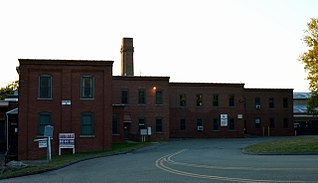
The Case Brothers Historic District encompasses a complex of homes, business, and recreational properties belonging to a prominent papermaking family in Manchester, Connecticut. The Case family owned and operated a paper mill from 1862 until 1967, built architecturally sophisticated residences, and minimally developed what is now the Case Mountain Recreation Area, a rustic public park in southeastern Manchester. Their properties were listed on the National Register of Historic Places in 2009.